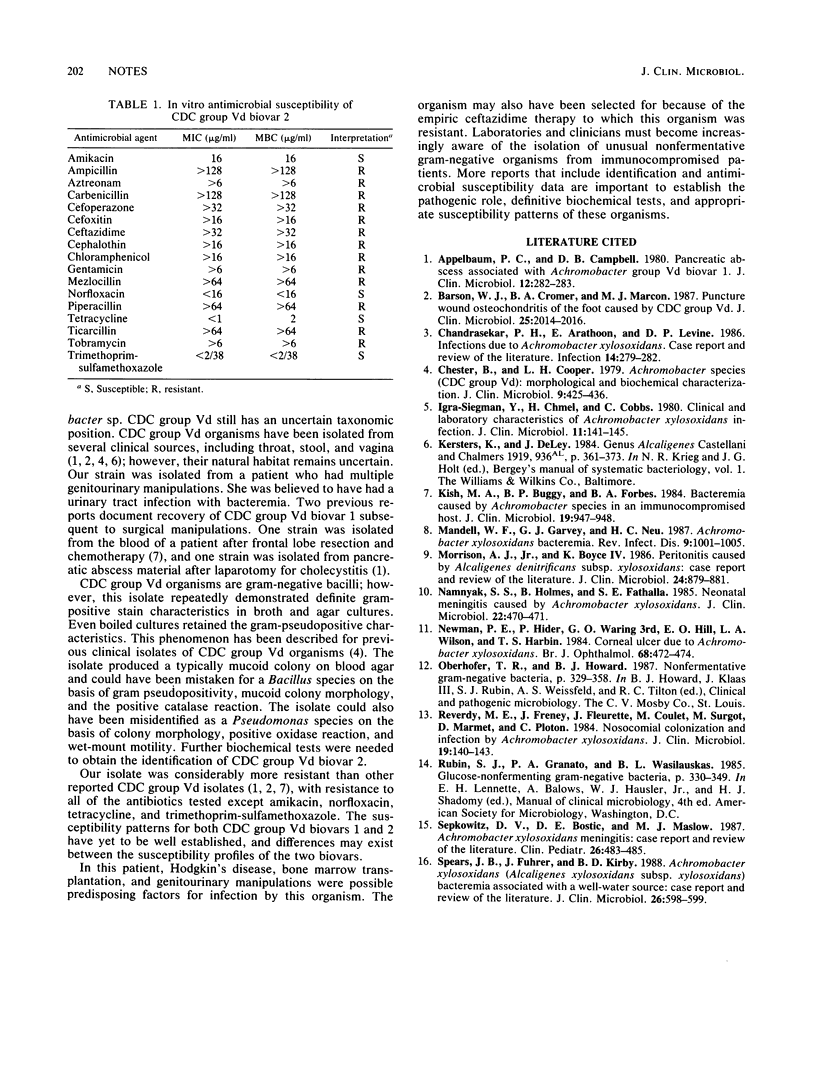Abstract
A case of urinary tract infection and bacteremia caused by CDC group Vd biovar 2 in a 23-year-old woman with Hodgkin's disease is described. This is the first report of CDC group Vd biovar 2 isolated from a clinical specimen and considered as a pathogen. Detailed antimicrobial susceptibility data are presented.
Full text
PDF

Selected References
These references are in PubMed. This may not be the complete list of references from this article.
- Appelbaum P. C., Campbell D. B. Pancreatic abscess associated with Achromobacter group Vd biovar 1. J Clin Microbiol. 1980 Aug;12(2):282–283. doi: 10.1128/jcm.12.2.282-283.1980. [DOI] [PMC free article] [PubMed] [Google Scholar]
- Barson W. J., Cromer B. A., Marcon M. J. Puncture wound osteochondritis of the foot caused by CDC group Vd. J Clin Microbiol. 1987 Oct;25(10):2014–2016. doi: 10.1128/jcm.25.10.2014-2016.1987. [DOI] [PMC free article] [PubMed] [Google Scholar]
- Chandrasekar P. H., Arathoon E., Levine D. P. Infections due to Achromobacter xylosoxidans. Case report and review of the literature. Infection. 1986 Nov-Dec;14(6):279–282. doi: 10.1007/BF01643962. [DOI] [PubMed] [Google Scholar]
- Chester B., Cooper L. H. Achromobacter species (CDC group Vd): morphological and biochemical characterization. J Clin Microbiol. 1979 Mar;9(3):425–436. doi: 10.1128/jcm.9.3.425-436.1979. [DOI] [PMC free article] [PubMed] [Google Scholar]
- Igra-Siegman Y., Chmel H., Cobbs C. Clinical and laboratory characteristics of Achromobacter xylosoxidans infection. J Clin Microbiol. 1980 Feb;11(2):141–145. doi: 10.1128/jcm.11.2.141-145.1980. [DOI] [PMC free article] [PubMed] [Google Scholar]
- Kish M. A., Buggy B. P., Forbes B. A. Bacteremia caused by Achromobacter species in an immunocompromised host. J Clin Microbiol. 1984 Jun;19(6):947–948. doi: 10.1128/jcm.19.6.947-948.1984. [DOI] [PMC free article] [PubMed] [Google Scholar]
- Mandell W. F., Garvey G. J., Neu H. C. Achromobacter xylosoxidans bacteremia. Rev Infect Dis. 1987 Sep-Oct;9(5):1001–1005. doi: 10.1093/clinids/9.5.1001. [DOI] [PubMed] [Google Scholar]
- Morrison A. J., Jr, Boyce K., 4th Peritonitis caused by Alcaligenes denitrificans subsp. xylosoxydans: case report and review of the literature. J Clin Microbiol. 1986 Nov;24(5):879–881. doi: 10.1128/jcm.24.5.879-881.1986. [DOI] [PMC free article] [PubMed] [Google Scholar]
- Namnyak S. S., Holmes B., Fathalla S. E. Neonatal meningitis caused by Achromobacter xylosoxidans. J Clin Microbiol. 1985 Sep;22(3):470–471. doi: 10.1128/jcm.22.3.470-471.1985. [DOI] [PMC free article] [PubMed] [Google Scholar]
- Newman P. E., Hider P., Waring G. O., 3rd, Hill E. O., Wilson L. A., Harbin T. S. Corneal ulcer due to Achromobacter xylosoxidans. Br J Ophthalmol. 1984 Jul;68(7):472–474. doi: 10.1136/bjo.68.7.472. [DOI] [PMC free article] [PubMed] [Google Scholar]
- Reverdy M. E., Freney J., Fleurette J., Coulet M., Surgot M., Marmet D., Ploton C. Nosocomial colonization and infection by Achromobacter xylosoxidans. J Clin Microbiol. 1984 Feb;19(2):140–143. doi: 10.1128/jcm.19.2.140-143.1984. [DOI] [PMC free article] [PubMed] [Google Scholar]
- Sepkowitz D. V., Bostic D. E., Maslow M. J. Achromobacter xylosoxidans meningitis: case report and review of the literature. Clin Pediatr (Phila) 1987 Sep;26(9):483–485. doi: 10.1177/000992288702600912. [DOI] [PubMed] [Google Scholar]
- Spear J. B., Fuhrer J., Kirby B. D. Achromobacter xylosoxidans (Alcaligenes xylosoxidans subsp. xylosoxidans) bacteremia associated with a well-water source: case report and review of the literature. J Clin Microbiol. 1988 Mar;26(3):598–599. doi: 10.1128/jcm.26.3.598-599.1988. [DOI] [PMC free article] [PubMed] [Google Scholar]


